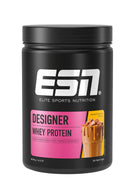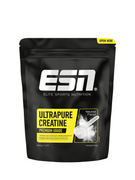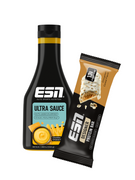Fettabbau
Der Abbau von Körperfett hat eine einzige Bedingung. Diese ist eine negative Kalorienbilanz am Ende des Tages oder besser der Woche oder des Monats. Wenn du mehr Kalorien verbrennst als du zu dir nimmst oder andersherum weniger zu dir nimmst als du verbrauchst, muss dein Körper die fehlende Energie aus Reserven bereitstellen. Diese Reserven sind vor allem im Speicherfett zu finden, sodass der Körper Fett abbaut, um die fehlende Energie bereitzustellen.
Wie genau dieses Kaloriendefizit erreicht wird, spielt dabei eine untergeordnete Rolle. Du könntest also sowohl über die Ernährung Kalorien einsparen, oder deinen Verbrauch über Bewegung erhöhen. Je größer das Defizit, desto mehr Fett nimmst du ab. Allerdings birgt ein zu großes Defizit das Risiko neben dem Fett auch Muskelmasse abzubauen und auch weitere Körperfunktionen einzuschränken. Damit würde auch dein Training leiden und ein Hauptantrieb des Fettabbaus nicht mehr optimal funktionieren. In der Praxis hat sich ein Defizit von 500 bis 1000 Kcal pro Tag bewährt, wobei es stark darauf ankommt, wie viel Fett du abnehmen möchtest, wie hoch deine aktuellen Kalorien sind und wie schnell du abnehmen willst oder musst.
Weiterhin ist es ebenso zweitrangig, durch welche Art des Trainings du dein Defizit erreichst. Ob Krafttraining, Cardio, Spazierengehen oder einfach weniger Kalorien konsumieren; Sobald du mittel- und langfristig eine negative Energiebilanz erreichst, wirst du an Körperfett verlieren.

Fettverbrennung
Demgegenüber bedeutet Fettverbrennung, dass während der Belastung, also während deines Trainings, Fett als Energieträger herangezogen wird. Dies gelingt vor allem bei geringen Intensitäten bis ungefähr 70 Prozent der maximalen Herzfrequenz. Daher wird der Bereich von 60 bis 70 Prozent der maximalen Herzfrequenz auch häufig als Fettverbrennungszone bezeichnet. Bei höheren Intensitäten nimmt der Anteil der direkt verbrannten Fette sehr schnell ab und es werden vor allem Kohlenhydrate verbrannt.
Falls eine negative Kalorienbilanz besteht, werden im Nachgang dann Fette aus den Speichern verbraucht. Dabei verlaufen beide Wege der Energiebereitstellung (Kohlenhydrate und Fette) stets parallel. Je höher jedoch die Anstrengung wird, desto geringer wird der Anteil der Fettverbrennung und desto höher der Anteil der Kohlenhydratnutzung. Das liegt daran, dass Fett nur in Anwesenheit von Sauerstoff verbrannt werden kann, der Kohlenhydratstoffwechsel benötigt diesen nicht unbedingt. Wenn du beim Training aus der Puste kommst, ist das ein grobes Anzeichen dafür, dass du hauptsächlich Kohlenhydrate verbrennst.
Während eines moderaten Trainings werden daher mehr Fette direkt verbrannt, als bei intensivem Training. Dadurch wird dein Fettstoffwechsel trainiert und dein Körper lernt langfristig vermehrt Fette während des Trainings zu verstoffwechseln. Sehr gut trainierte Ausdauerathleten zum Beispiel können auch bei deutlich höheren Intensitäten als 70% noch nennenswert Fette als Energieträger nutzen, weil sie einen sehr gut trainierten Fettstoffwechsel haben. Vor allem bei langen und intensiven Trainings und Wettkämpfen ist diese Fähigkeit unerlässlich, da auch die vollsten Glykogenspeicher irgendwann leer sind, die Fettreserven aber verhältnismäßig groß sind.
Was ist besser?
Bei dieser Unterscheidung ist es sehr wichtig zu verstehen, dass während der Fettverbrennung anteilig mehr Fette verbrannt werden. Das bedeutet, dass der Anteil der insgesamt verbrauchten Kalorien zu einem höheren Anteil aus Fetten besteht und nicht, dass insgesamt mehr Fett verbraucht wird. Dies ist meistens beim Fettabbau der Fall, da durch höhere Trainingsintensitäten auch mehr Kalorien verbrannt werden und dadurch nach dem Training die Fettdepots in höherem Maße angezapft werden können.
Ist demnach die Fettverbrennung schlechter? Nein, denn, wie bereits erwähnt, dient das Training des Fettstoffwechsels mittel- und langfristig dazu, auch bei intensivem Training noch Fette verbrennen zu können. Demnach ist das Ziel dieser Trainingsform in gewisser Weise ein anderes:
Während das Ziel des Fettabbaus direkt mit den verbrauchten Kalorien zusammenhängt und die Art der verbrannten Substrate während des Trainings zweitrangig ist, zielt die Fettverbrennung nicht auf einen maximalen Energieverbrauch, sondern einen möglichst effizienten Energieverbrauch ab. Weiterhin ist ein gut trainierter Fettstoffwechsel nicht nur für die Abnahme von Körperfett, sondern wie bereits erwähnt auch für die sportliche Leistungsfähigkeit bei langen Einheiten wichtig.

Warum nicht beides?
Demnach sollte die Frage nicht lauten „Was ist besser?“ sondern eher: „Warum nicht beides?“ – Es ist schließlich naheliegend, dass ein möglichst hoher Kalorienverbrauch kombiniert mit einem möglichst hohen Anteil an verbrannten Fetten synergistische Effekte aufweist. Daher solltest du auch beide Trainingsformen miteinander kombinieren, um optimal an Körperfett zu verlieren und die Leistungsfähigkeit zu steigern.
Verwende für dein Fettstoffwechseltraining eher moderate Intensitäten bis 70 Prozent der maximalen Herzfrequenz für längere Einheiten. Wer ohne Herzfrequenzmesser trainiert, sollte darauf achten, nicht zu sehr außer Puste zu kommen. Für einen möglichst hohen Kalorienverbrauch und optimalen Abbau von Körperfett darfst du ruhig auch intensiver und dafür kürzer trainieren oder in lange Einheiten Intervalle einbauen.
Aber Achtung: Vor allem Anfänger neigen dazu, schnell in hohe Herzfrequenzbereiche zu kommen, weil sie noch keinen gut ausgeprägten Fettstoffwechsel und Grundlagenausdauer haben. Nach einem Intervall senkt sich die Herzfrequenz weiterhin nur sehr langsam wieder ab, weswegen eine Trennung der Intensitäten in mehrere Einheiten sinnvoll sein kann.
Wer regelmäßig Krafttraining betreibt, befindet sich wahrscheinlich während der Trainingssätze ebenfalls phasenweise in den höheren Herzfrequenzbereichen und ist dort vermutlich besser trainiert, als in den niedrigeren Bereich. Bei den meisten Kraftsportlern ist daher ein Grundlagenausdauertraining bzw. Fettstoffwechseltraining die bessere Cardio-Ergänzung.
Was die Fettverbrennung unterstützt
Wenn du deine Fettverbrennung im Training weiter unterstützen möchtest, kannst du noch einige Dinge beachten. Zum einen kann Coffein die Fettverbrennung anregen und daher die Energiebereitstellung über Fette während des Trainings erhöhen und gleichzeitig über Effekte auf das zentrale Nervensystem die Wärmeproduktion und damit den Energieverbrauch vergrößern. Weiterhin kann Coffein dadurch auch die körperliche Leistungsfähigkeit sowie den mentalen Fokus verbessern und damit zu einem erhöhten Energieverbrauch beitragen. Damit unterstützt Coffein sowohl den Fettabbau, als auch die Fettverbrennung und kann ergänzend für dein Training sinnvoll sein.
Darüber hinaus konnten bereits mehrere Studien zeigen, dass die Bereitstellung von Fetten im Training umso besser funktioniert, je leerer die Glykogenspeicher waren. Daher kann vor allem moderates Fettverbrennungstraining im nüchternen Zustand die Verwertung von Fetten und damit den Anteil der Fetten an den Gesamtkalorien erhöhen. Nüchternes Cardiotraining verbessert daher das Fettverbrennungstraining noch weiter. Aber auch eine High-Fat Ernährungsweise kann die Oxidationsrate von Fetten erhöhen.
Aber Vorsicht. Zu hohe Intensitäten auf nüchternen Magen können dazu führen, dass statt der fehlenden Kohlenhydrate wertvolle Proteine als Energieträger herangezogen werden, anstatt als Baustoff zu dienen. Obwohl auch nach einer Phase ohne Energiezufuhr die Glykogenspeicher selten ganz entleert sind, kannst du dennoch auf Nummer Sicher gehen und vor dem Training EAAs als Muskelschutz zu dir nehmen, um dem gefürchteten Muskelschwund durch Cardiotraining vorzubeugen.
Fazit
Beim Fettstoffwechseltraining verbrennst du während des Trainings direkt einen hohen Anteil an Fetten. Dagegen werden beim Fettabbau während des Trainings vermehrt Kohlenhydrate abgebaut und die fehlende Energie im Falle einer negativen Energiebilanz aus Fettspeichern mobilisiert. Während Fettverbrennung vornehmlich bei geringen bis moderaten Intensitäten auftritt, jedoch aber trainierbar ist, werden bei höheren Anstrengungen vor allem Kohlenhydrate verbrannt. Sowohl für den Abbau von Körperfett, als auch für den Aufbau der Leistungsfähigkeit ist es sinnvoll beide Trainingsformen miteinander zu kombinieren. Supplemente wie Coffein und Aminosäuren können dabei dein Training sinnvoll unterstützen.








